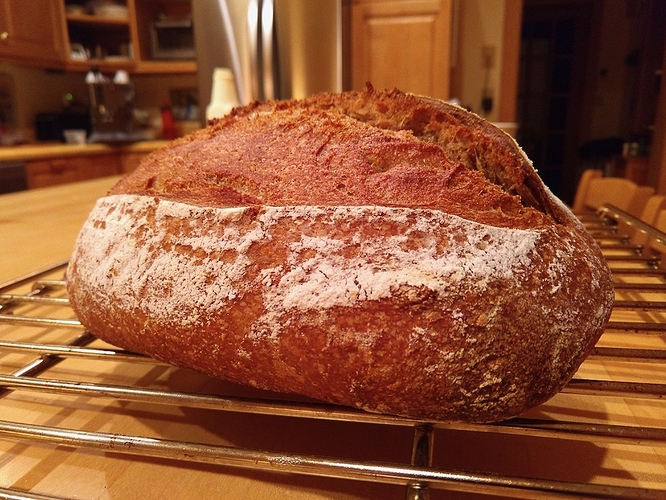As part of a conversation with Melissa (@Fermentada) about a project that she’s working on, I created a from-scratch new sourdough starter recently. The main starter that I’ve been using for a while is descended from the live starter which I got something like 5 or 6 years ago from Breadtopia. Since then, I’ve created a lot of different offshoots of that original starter by taking small samples and feeding it this or that flour. And I’ve had some other starters from other sources over the years. But I’d never created one from scratch before, so when Melissa and I were chatting about it, I decided I’d try it.
If you’ve read any of the stuff I’ve posted here, I’m sure it will come as little surprise that I decided to ignore the conventional wisdom about how to make sourdough starter. I’m calling my method the do-nothing sourdough starter method. It goes like this:
Step 1: mix small, equal-weight amounts of white bread flour and un-chlorinated water together.
Step 2: do nothing.
I guess there is a sort of step 2.5 which is: pay attention. But that’s part of everything bread baking to me so it feels weird to call it a separate step. Anyway, it was an interesting exercise. Here’s some of what I noticed.
After about 48 hours or so, my new starter was bubbling away and had doubled in volume. That seemed too fast and too simple, so I wondered if I had accidentally inoculated the new starter with the old one somehow. But when I stuck my nose in the little jar, I noticed that it did not smell right. The familiar scent of starter was there in the background, but there was a lot more of a different, unpleasant odor shoving its way to the front of the overall aroma, so I knew that some, or maybe most, of the activity I was seeing in there was not the result of the metabolic activity of our favored little beasties.
And that led me to consult The Google where I learned a lot which I will not belabor you with. I’ll just boil it all down to this vast oversimplification. Initially, when I mixed up the flour and water, the pH in there was pretty close to neutral. In that environment, there are a lot of bacteria that can use the dough as food and that will produce gas as they eat. Looks like “starter” bubbling. Smells like something else.
Over time, the microbial population tends to shift in favor of acid (sour) producing bacteria which lowers the pH and creates an environment that is suitable for both those acid-producers which we like, as well as the various species of yeast that produce C02 which we also like. Once the pH gets low enough and a dynamic equilibrium is reached among the favored microbes, the environment created so favors those microbes over all the others, that virtually everything we don’t want growing in there - i.e. the bacteria that was creating my initial bubbles - dies off and the microbial culture that is left to flourish in that environment is the exact one we like to use to leaven our bread.
So, having learned all this about the genesis of a starter culture, I re-doubled my efforts on step 2 by doing more of nothing. After another 24-36 hours, the bubbling stopped and the consistency of the mix in my little jar turned to absolute liquid. It looked totally lifeless. But it smelled more and more sour and closer and closer to what I am used to smelling when I open my starter jar. So I just kept on doing step 2. Another 24 hours or so down the road although it looked dead and dare I say pretty flaccid, it really was smelling pretty good and so I thought I should maybe feed it. So I poured off a bunch of the liquid and mixed in some fresh flour and water. A few hours later I started seeing some signs of bubbling and familiar (pleasant) smells in the jar. At that point, I concluded that a new starter was born.
I let it sit out for a while and ferment and then I stuck it in the fridge and a couple days later I baked a loaf of bread with it.
The bread was good, but there were some subtle, but noticeable differences between it and what I am used to when I follow the methods I used to produce the loaf. One thing that was different was that even though I used the same temperatures and timings as usual, both the crust and crumb were paler in color than my usual bread. Another thing that was different was the flavor. Always hard to describe this kind of thing, but it was missing a certain depth and complexity that Mrs. homebreadbaker and I have become used to. She called it “immature”. Finally, I noticed that it seemed to stale a couple days faster than my usual loaf.
Not to be deterred, I left the starter in its little jar in the fridge with the presumption that the little beasties would get their act together given more time and so I baked again with it over the weekend (another week having passed), and this weekend’s loaf is much more along the lines of what I usually get, so I think my presumption seems to have played out. I just fed the new starter again this morning and it really is smelling, looking, acting more or less exactly the same as my original starter now.
So I am declaring the do nothing sourdough starter method to be a success, though it did take a bit longer to come to full fruition than I had originally expected.
